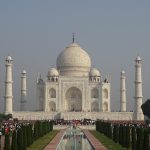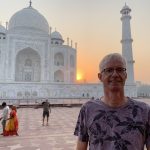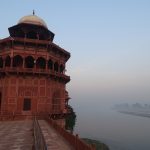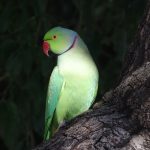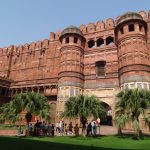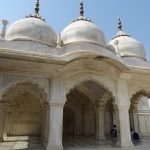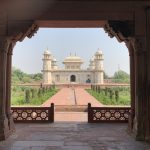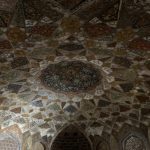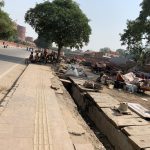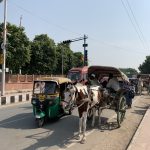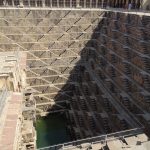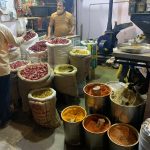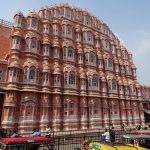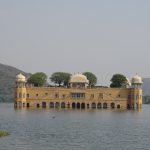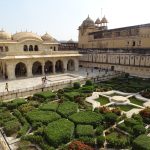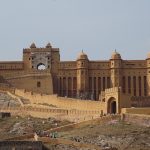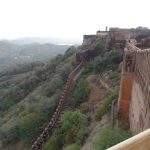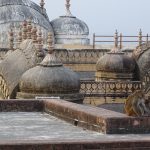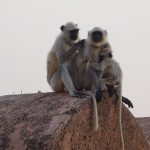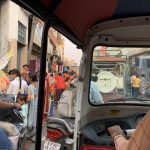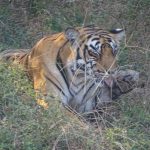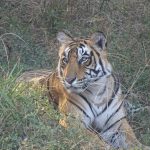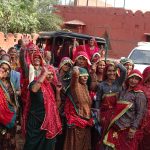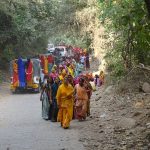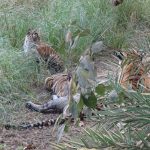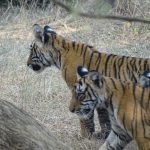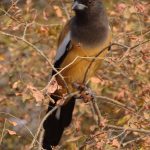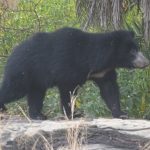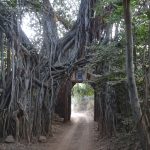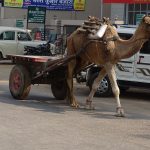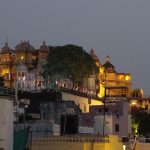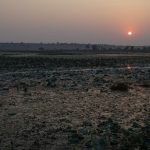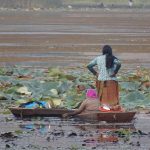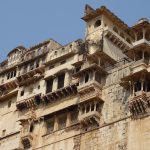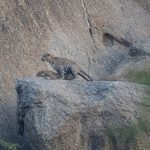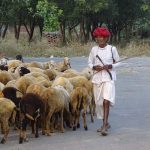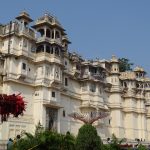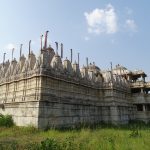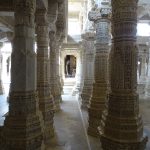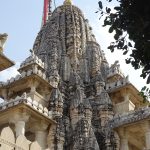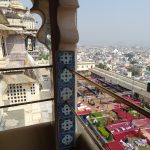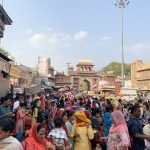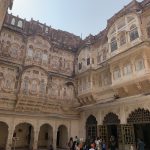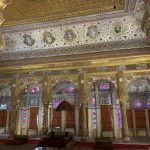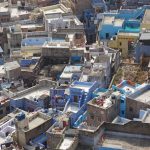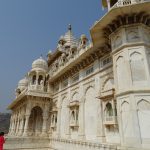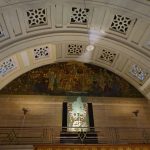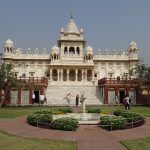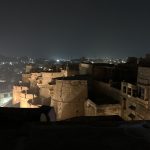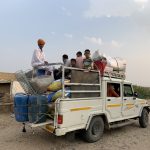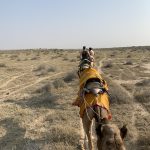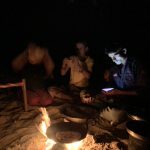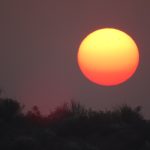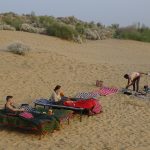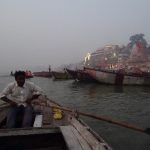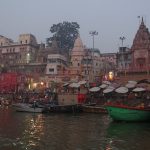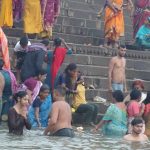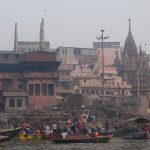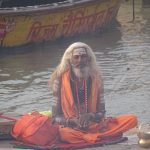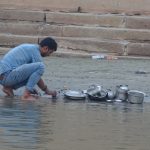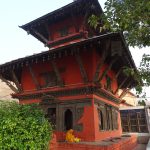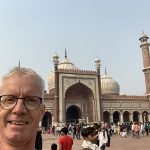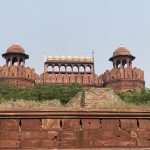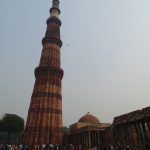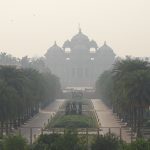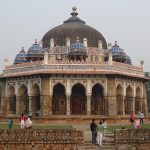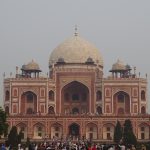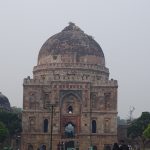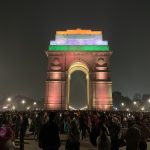Saturday October 28
We left for the north from the south sometime very early in the morning. I arrive in New Delhi around noon. Here I meet Jeroen, with whom I will travel through the north in the coming weeks. The taxi takes us to the train station, but first the driver manages to arrange a few tickets for us through a friend. The train leaves from platform 4, luckily we discover in time that this has become platform 5 after all. We share the compartment with an Indian family and he has worked in Europe, including in the Netherlands. During the animated conversation we learn some useful tips. Including about the train app RailYatri and Uber. With the latter you can also arrange the tuktuk, motorcycle taxi and intercity taxi here. We arrive an hour late and immediately use the Uber app. At the airport we bought an Airtel SIM for just 450 rupees (€5) (1.5 GB/day 4G for a month) and the train journey takes just long enough for the SIM card to be activated. Unfortunately there is no internet at the station for a while, so I decided to make a deal with the local tuktuk. Check-in and rooftop bar.
Up at 5 o’clock on Sunday morning and walking through the awakening city. The city is still dark and the full moon shines in the streets. Here and there people are making preparations for the day. The dogs wander around, but are not aggressive. Then a call on a motorcycle. The dogs run towards it, apparently this man feeds the dogs more often. Some cows are grazing in the dirt and residents are cleaning the street with water. We arrive at the east gate and join the queue for foreigners. We have already booked the tickets online. A long line, but it moves quite quickly. Backpack through the scanner and enter through the gate. Then we see the Taj Mahal. A sublime white marble mausoleum with a beautiful garden in front of it. With the rising sun this gives a great sight. A light mist hangs along the shore and the red sky gives this monument a special glow. A tour around the outside and then queuing for the inside. The finish both outside and inside is great. Impressive and fantastic to be here. Although this is of course difficult to beat, India has more to offer and we want to experience it. Also in Agra, such as the fort and the beautiful mausoleums of Akbar and I’timad-ud-Daulah. As we walk from the fort to a well-known mosque through a lesser part of the city, people lie on “beds” in the shade of a tree along the road, their tent camp in the background and the riverbed full of garbage. Around the mosque there is one large bazaar, where people crowd the colorful stalls and scooters and tuktuks use every space to maneuver through the crowds.
The next day a Zata Zest as Uber Intercity takes us to Jaipur. Along the way, visit the Chand Baori Step Well, 13 floors with steps that go deeper and deeper into the ground, about 30 m deep and which, after all these centuries, still contains water. The Hawa Mahal should not be missed in Jaipur. Not convincing on the inside, but the distinctive front is beautiful. It’s just not easy to enjoy this with the madhouse of traffic that rushes past. The city has a lot to offer, but the enormous Amber Fort is a must. Quite a climb up, but beautiful. We continue up to also see Jaighar and Nahargah Fort and take in the views of the city and the surrounding area. With the monkeys on the roofs and a mini Chinese Wall over the surrounding mountain peaks.
We take the train on Wednesday. The tickets can be booked via the app, at least in theory, because it doesn’t work. Internet and WiFi are often optional in India, but government and internet are difficult to combine here. Nice sites and apps, but that’s it. Fortunately, the counter clerk at the third counter referred to is willing enough to issue tickets. This is not often the case during our trip. The others do not bother and refer directly to commercial parties, who then complete the entire “survey” for a small commission. Although we leave too late, the Ranthambore Express arrives well on time. Our open car arrives on the sidewalk an hour earlier than agreed and we can just grab a packed lunch. At the entrance to the park, thousands of women in brightly colored dresses gather and walk into the park in a long line of people. They share the road with the open safari cars. 5 km into the park is one of the most important Geshna temples and because of a festival 100,000 women come to the temple in two days. We turn off and drive into nature. Deer, birds, black-faced monkeys and wild boar everywhere. We drive further and deep in the park we see where we came for. That is, the guide points to the tall grass and says that there is a tiger among them. Hmm… As a layman we see nothing. Then the tiger gracefully comes out from behind the grass to hunt for a tasty snack that is a little further along the river, in the shape of a deer. The deer notices him, gives the alarm cry and runs away. The tiger then decides to rest along the river and lick the fur clean. Fantastic sight. The next day we go on safari again, this time we follow the crowds to the temple before turning to another sector, sector 3, in the park. According to the ranger, the most beautiful part of the park. The landscape is beautiful with the lakes and some old buildings. We soon see a sloth bear, which quickly runs away and does not show up again. The tiger has been spotted. When we arrive on site we see her walking. She walks quietly through the forest towards the water. Between the wagons and then into the reeds. We hear her growling and after a while she comes out again and lies down just outside the reeds. Then three young tigers come to their mother. Incredible. Mother tiger eventually crosses the road and the little ones timidly follow and disappear together into nature. Afterwards we deserved some pool time.
The next day we take the train to Kota and then a taxi via the Taragarh Fort in Bundi, located against the mountainside, to our cabin at Pangarh Lake. The terrace offers a view over the lake filled with lotus plants. The birds and people in boats harvest lotus seeds here. Fortunately, the loud diesel generator on the lake turns off after an hour and we can actually enjoy the peace and quietness. Only the mosquitoes around sunset ruin it a bit. The boiler has not (yet) been installed and in the morning you have to “shower” with a tap from the barrel of hot water.
In Udaipur our hotel is located on the large lake with a view of the city palace and the palaces in the lake. There was a big wedding in the city palace and during the visit we see how the remains are being cleaned up in the garden. We go from room to room through the palace, decorated with beautiful arches, paintings and glass motifs. The city offers also some temples and shops.
On the way north we make a stopover. In Ranakpur we booked a luxury hotel to relax by the pool. The road meanders through the mountains and the views are amazing. Take off your shoes in Ranakpur and visit the old Jain Temple. A large marble structure with apparently more than 1000 columns, richly decorated with sculptures. Wonderful. When we check in, we are asked in passing if we are interested in a leopard safari. Still possible this afternoon. we had no idea there was a nature park here, but we couldn’t pass up such an opportunity. The 4×4 driver takes us to a lake and some nice rocky hills. Then a circle around some large rocks until we see where we came for. A leopard lies on top of the rocks and not much later the female emerges. She seduces him and the grunts of mating can clearly be heard.
The next morning we relax by the pool and travel to Jodhpur in the afternoon. On the roof terrace in Jodhpor we enjoy the view of the illuminated fort during dinner. After all those curries today, I try a mushroom paneer burger with fries. I must say that fries with a cashew curry sauce are a truly golden combination. The nearby step well is located in the middle of the district and can still be visited freely. We struggle through the streets past the market stalls and crowds around the clock tower on our way to a tuktuk. Only a small part of the Umaid Bhawan Palace can be visited, but the white Jaswanth Thada on the mountain is a beautiful mausoleum. From here it is not a far walk to the large and beautiful fort. From the wall there is a good view of the blue city and back we walk downhill through the winding streets where children wave friendly and shout “hello”. The next day we immerse ourselves in the hustle and bustle of the city and browse the shops on the hunt for some souvenirs. Along the way we give the local hairdresser a try and at the end of the afternoon we take the train to the east. This has a long delay, but we still arrive in Jaisalmer around midnight.
The hotel is located within the old fortress and in the morning we visit the city palace and the many shops. In the afternoon, together with mother and daughter, Marianne and Emma, we can follow the driver who takes us to Baran in his car. Apparently this is his family village in the desert and we drink chai with the family. Visit a ghost town along the way and then our next transport is already waiting just outside the village. We are allowed on the camels and take a trip through the desert landscape with small bushes until we reach a strip of dunes. Here we camp and the driver and the camel driver make a campfire on which our evening meal is prepared. Time for us to enjoy the view on top of the dunes and after the excellent meal it is time for some music. First camel songs and later the Bluetooth speaker. Cozy and fantastic to see all those stars at almost a new moon. We spend the night on camp beds with thick blankets against the cold of the night. In the morning, one of the camels appears to be disappeared and an alternative caravan is arranged from a brother. Along the way we see more antelopes and wild camels. Wonderful.
On Saturday we fly to what is one of the oldest continuously inhabited cities in the world, Varanasi. Expectations are high. The next morning we are ready around 5 am and walk together with the families to the river Ganges. Entire families already immerse themselves in the river here. The rowers come here in droves and we row back and forth along the riverbed, just like so many others, Indians and tourists. We see the people in the sacred river, the palaces of all those kingdoms that also had a palace here along the bank, temples and the famous cremation grounds. Impressive. On the other side of the river is a large, almost empty, beach where tourists can take camel rides. We walk through the narrow alleys of the city, encountering processions competing for space with the people and scooters. A stream looks more like a waste mountain and we wonder how healthy it is to immerse in the river here. Holy or not.
Our last stop is New Delhi. The taxi driver explains that there is a ban on fireworks due to the poor air quality. In recent days it has been an all-time high for smog. We don’t notice much of this ban in the evening, fireworks are set off everywhere, which can be clearly seen from the roof terrace. The next morning we walk to the Jama Masjid, the big red mosque. In the Muslim neighborhood there are almost only men on the streets, where you can buy car doors and other parts in narrow alleys that are only accessible by foot or scooter. Special. The mosque is popular and the large square is well filled, as is the road with stalls towards the Red Fort. The fort is closed, but still worth a visit from the outside. By metro to Qutab Minar, about 20 km further south in the city. This minaret from around 1200 is 72 m high and, together with the surrounding buildings, very impressive. Askhardham is located in a thick layer of fog and can only be admired from a distance, the mausoleum of Humayun, located a little further away, is the same work as the architect of the Taj Mahal. A lot simpler, but also beautiful. In Lodhi Park more old mausoleums and then a visit to the India Gate. Nicely lit in the evening and bizarrely busy.
We fly back tonight, so we take an taxi to the airport on time. He is still trying to scam us by supposedly not having any change. We have time (we think), so let’s play the game. Turns out he has money after all. Then check in our luggage. The KLM counter directs us to the self-check-in. No problem. The device accepts the luggage and directs us to the customs office for the next step. There is a long line here and after 40 minutes it is our turn. The customs officer checks everything and the result is that I have to go back for a stamp on the plane ticket. I explained to him that it is self-checkin and therefore no stamp. Well. That is not possible. He tells me to wait a moment and calls a colleague to go after it. Then I can follow a colleague and wait again. Half an hour later someone brings my passport and plane ticket with the stamp and I can go to the next row, in front of the baggage scanner. Jeroen, like many fellow passengers, had already walked back for a stamp. No one from KLM knows anything until the customs officer in question clearly tells them this. Ultimately we are back in the next row at about the same time. Here we can wait another 1.5 or 2 hours before it is our turn. What a mess. Once we have passed through the scanner, we have to walk briskly to the other side of the terminal to reach our gate on time. We thought we were 4 hours early, but we just caught the plane. We are not the only ones and on the plane some missing passengers are called and they wait for a while. The flight itself goes smoothly and we arrive in Amsterdam on time.

